This showstopper dessert involves a meringue base with a crisp exterior and a marshmallow-like center topped with whipped cream (or lemon curd) and a medley of fresh fruits, usually berries. It's elegant and simple at the same time and can accommodate different topping combinations.
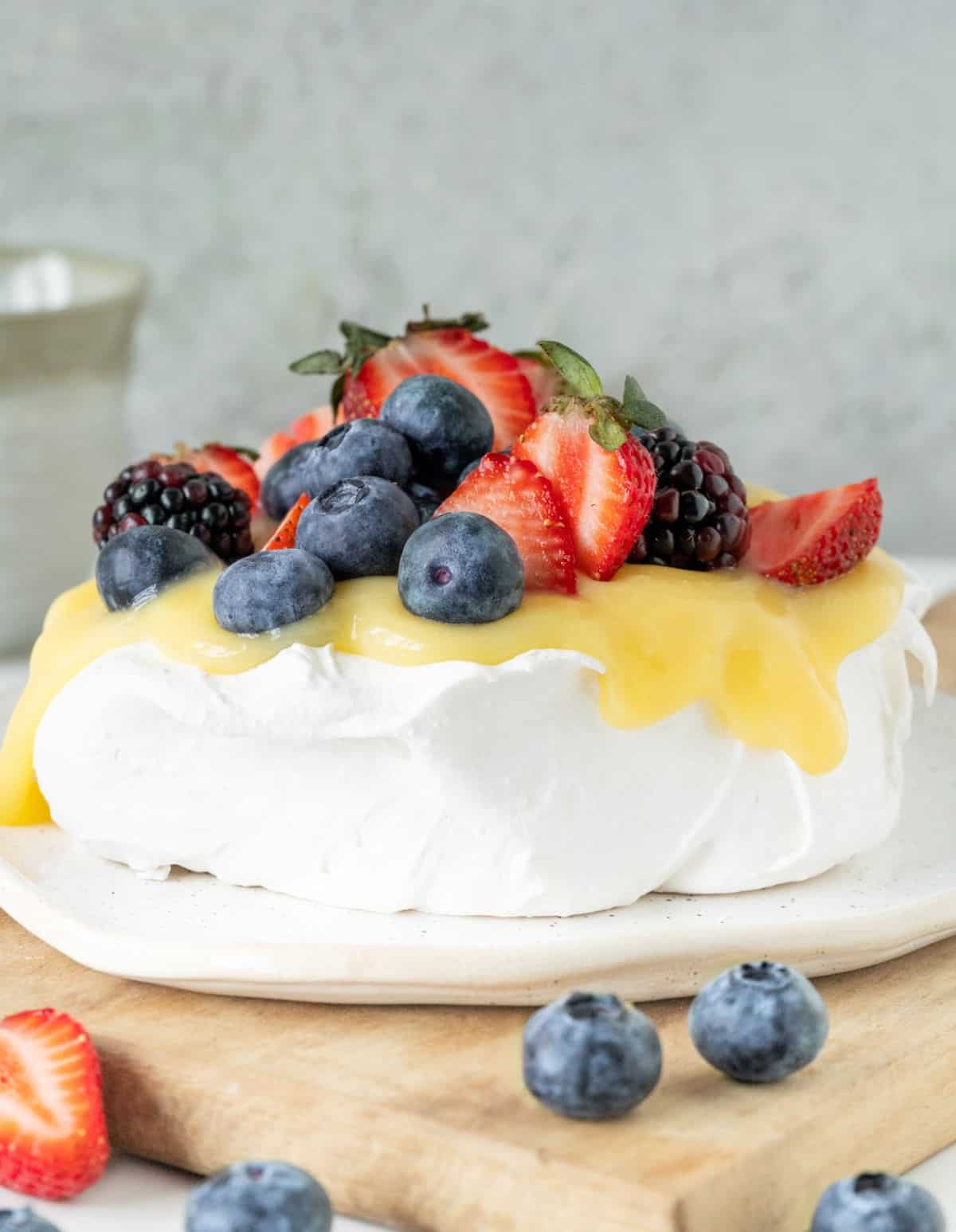
A showstopper dessert
This dessert, named after the legendary Russian ballerina Anna Pavlova, is a heavenly creation of light, airy meringue topped with a generous dollop of cream and seasonal fruits.
Its versatility allows for endless creativity in choosing toppings, making it an elegant dessert that can be adapted to different holidays and occasions with your favorite fruits, sauces, and edible flowers.
It's especially beautiful for Mother's Day and around Christmas time.
We usually make two types of pavlovas: lemon curd with fresh berries or fresh whipped cream with cherries or strawberries.
You can make the classic pavlova recipe (one large round) or small individual ones.
This meringue-based dessert is part of our more sophisticated but simple dessert list, along with other favorites like black forest tarts and chocolate torte.
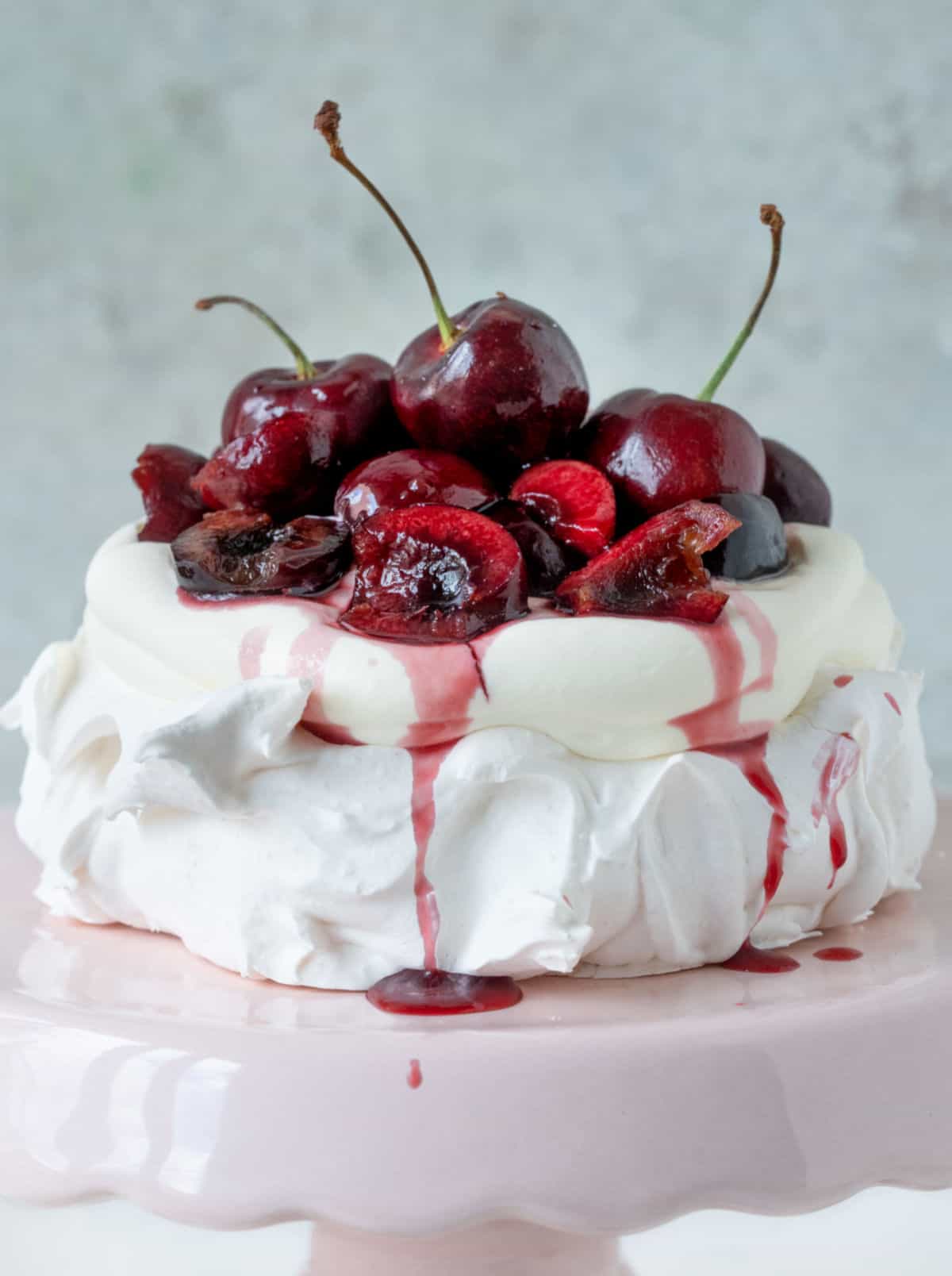
Ingredient list
- Egg whites.
- White granulated sugar.
- Cornstarch: it’s used for texture. Argo 100% pure cornstarch is a popular one.
- White vinegar: not white wine, but distilled white vinegar like Heinz.
Quantities are listed on the recipe card towards the end of this post. The Ingredients page has more details and lists the brands we use.
While meringue and pavlova are made from whipped egg whites and sugar, pavlova is a specific dessert with a specific structure and presentation. It is baked to have a distinct contrast in texture between its crispy exterior and soft interior and is usually served with cream and fruit toppings. Meringue is a more versatile component that can be used, baked or unbaked, in various dessert preparations. The interior is usually crisper than that of a pavlova.
Fresh eggs are recommended for a pavlova for stability and volume. They are firmer and more stable, which makes it easier to whip them into stiff peaks. They can hold more air and create greater volume when whipped and are less likely to deflate or lose their volume during the whipping and baking process, resulting in a more successful pavlova.
Cornstarch contributes to a smoother and more homogeneous meringue and helps create the signature pavlova texture, which is crisp on the outside and soft and marshmallow-like on the inside.
It helps absorb excess moisture from the egg whites, which can be beneficial for maintaining the pavlova's structure during baking. This added stability reduces the risk of the pavlova collapsing or weeping as it cools.
Vinegar helps with stability, texture and flavor. The acid in vinegar helps stabilize the egg whites during whipping and helps ensure that the pavlova's interior remains soft and spongy while the exterior becomes crisp during baking. It can help balance the sweetness of the meringue and toppings without imparting flavor to the pavlova; you don't taste it.
Yes, you can, same volume (teaspoons). So, use an equal amount of lemon juice as the amount of vinegar called for in the recipe.
Vintage Kitchen Tip
Pavlova uses egg whites so what to do with the egg yolks is always an issue. Use them to make a batch of lemon curd and use it as a topping together with fresh berries.
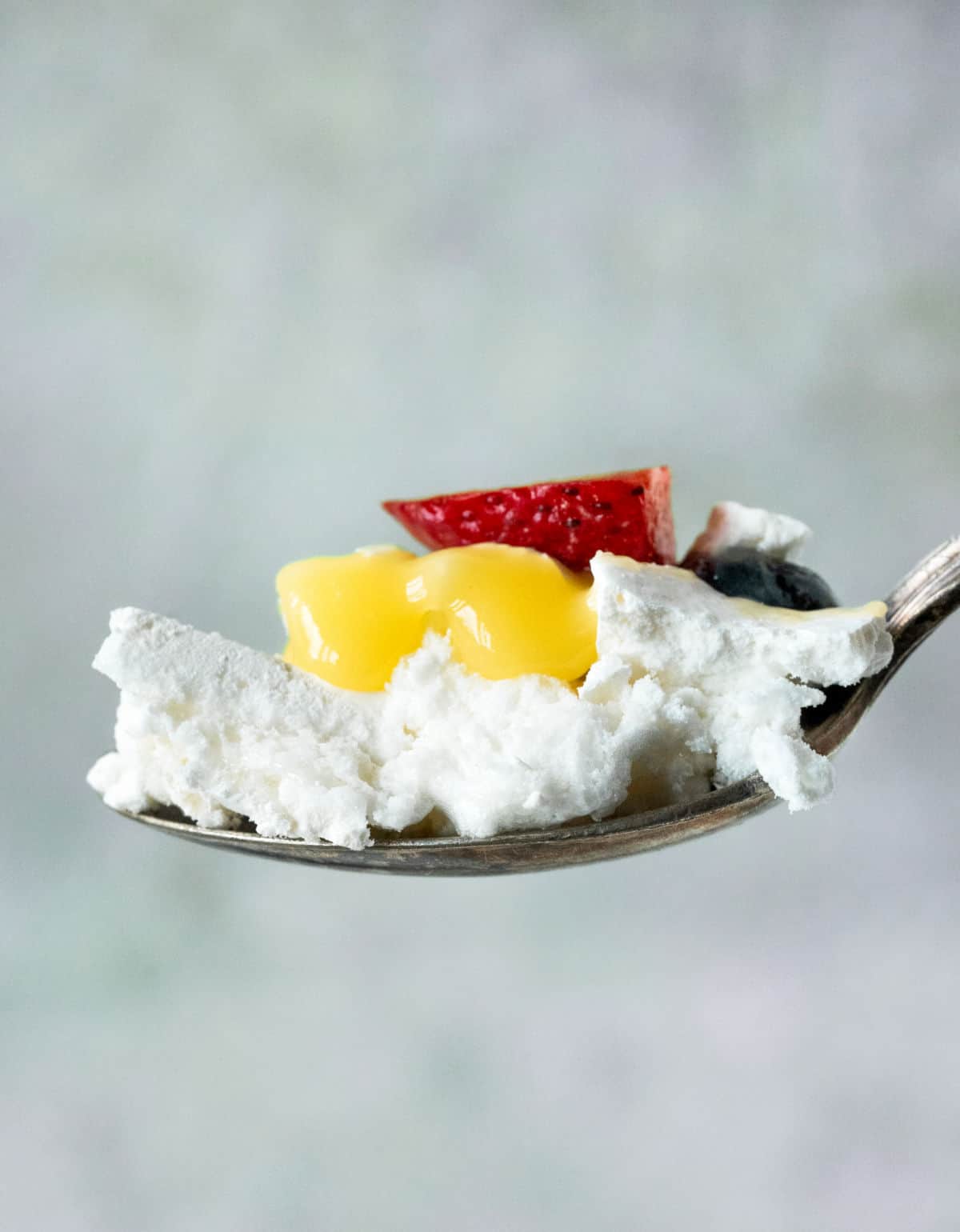
How to make a perfect pavlova
- Organization: read the recipe first and ensure you have ingredients at the correct temperature, equipment, and enough workspace. This will make the process so much easier.
- Fresh egg whites at room temperature: this is essential.
- Adding sugar: the egg whites are whipped until they start to show a peak, and then the sugar is added gradually.
- Beating the meringue: the easiest way is to use a stand mixer with the whisk attachment. Then comes an electric mixer, and it usually takes a little longer.
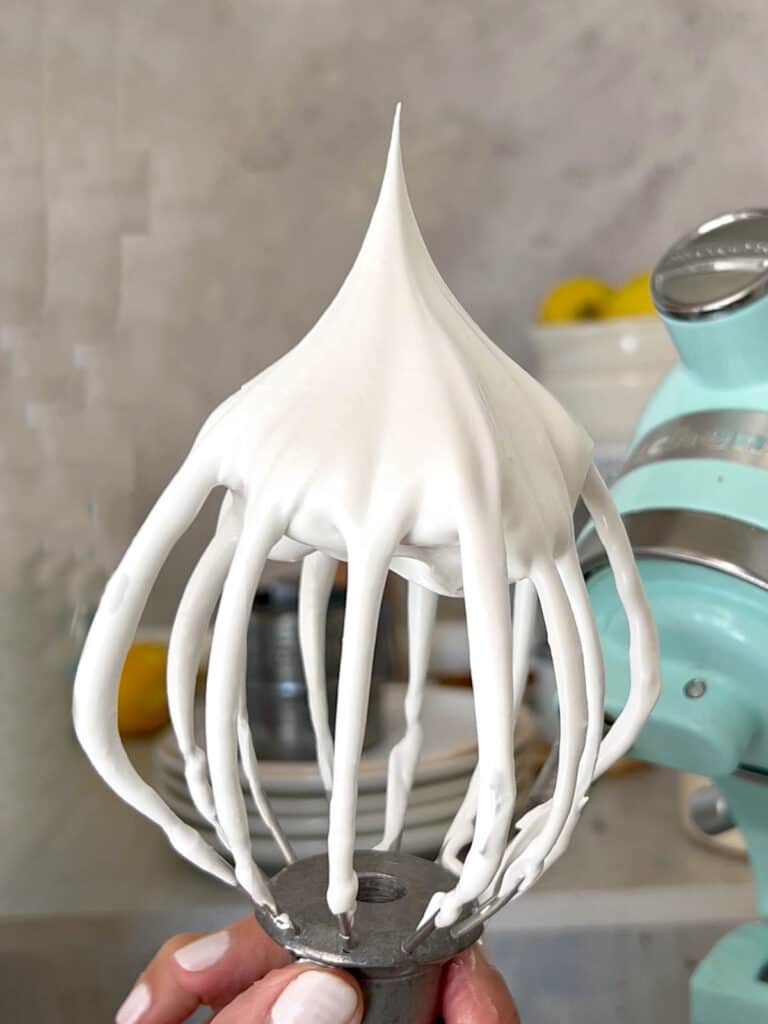
Meringue
This is what firm peaks look like; the tip is straight with no tilting. This is the right consistency for a pavlova.
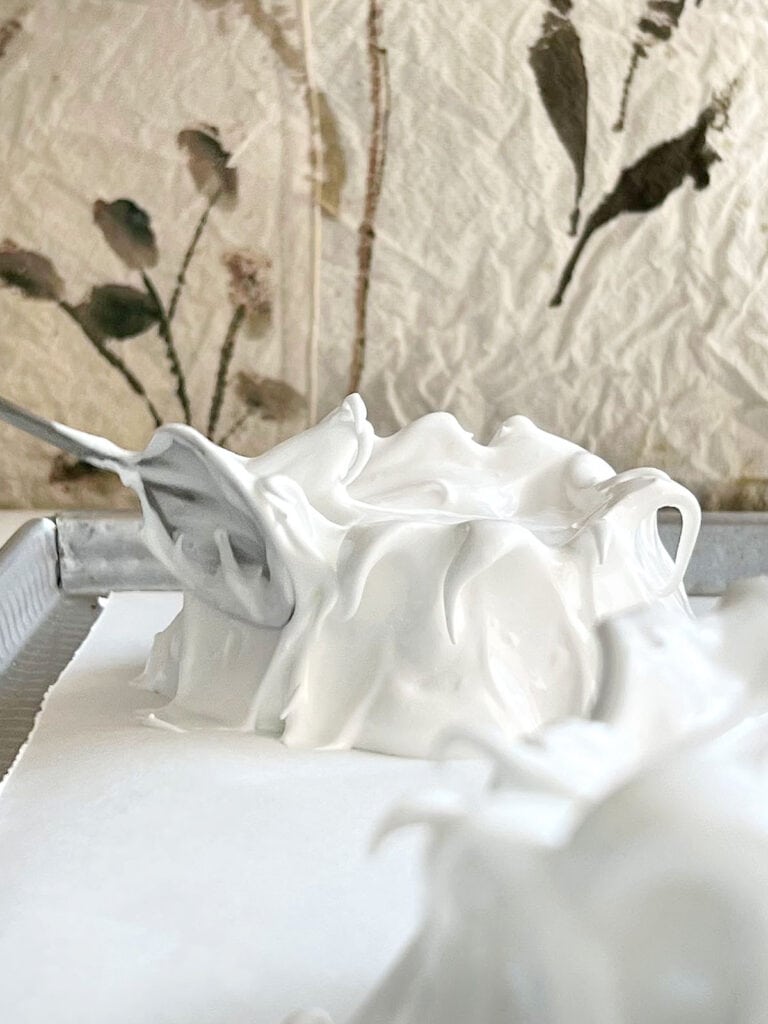
Tall nests
Use the back of a spoon to form the high sides, lifting the meringue mixture upwards with a sweeping motion. It yields about 6 mini pavlovas.

Flat circles
Or make flatter circles for a different ratio of meringue and filling. The baking time will be less.
Baking Pavlova
IMPORTANT: Make sure the oven is turned down the second you put the baking sheet in. The temperature for baking this meringue is very low; make sure your oven is well calibrated.
Baking time: consider that all ovens and pans are different, even if they look similar. The baking time in my recipes is as accurate as possible, but it might take you more or less time. You can use a thermometer(like the OXO oven thermometer) to check that your oven is at the right temperature. I recommend keeping track of how your oven works and what tiny details you might need to adjust.
Practice makes perfect because pavlovas are baked in different shapes and sizes. But characteristics of a baked pavlova are: a crisp outer shell that is dry to the touch with firm edges, the center should feel slightly soft when gently touched, the meringue is easily lifted from the parchment paper without sticking (this is key) and it doesn't have severe cracks. Some minor cracks might develop as it bakes and cools.
The most common reasons are the oven is not low enough, and you're overbaking it. Make sure the sugar is dissolved during whipping, the oven is well calibrated (you can use an oven thermometer to check the temperature) with a very low setting, and you don't overbake it, letting it stay inside after the oven is turned off. All is explained in the recipe card.
Serving
Transfer the meringue disk to the serving plate or platter and add the topping right before serving.
Toppings: there is a long list of topping combinations that work to transform a pavlova into your perfect dessert. Try passion fruit curd with fresh fruit, chocolate whipped cream with chocolate sauce and caramel, pastry cream and fresh fruit, or whipped cream with lemon curd and berries. Find your favorite and make your signature pavlova dessert.
Choose different combinations depending on the occasion and personal taste. These are our favorites.
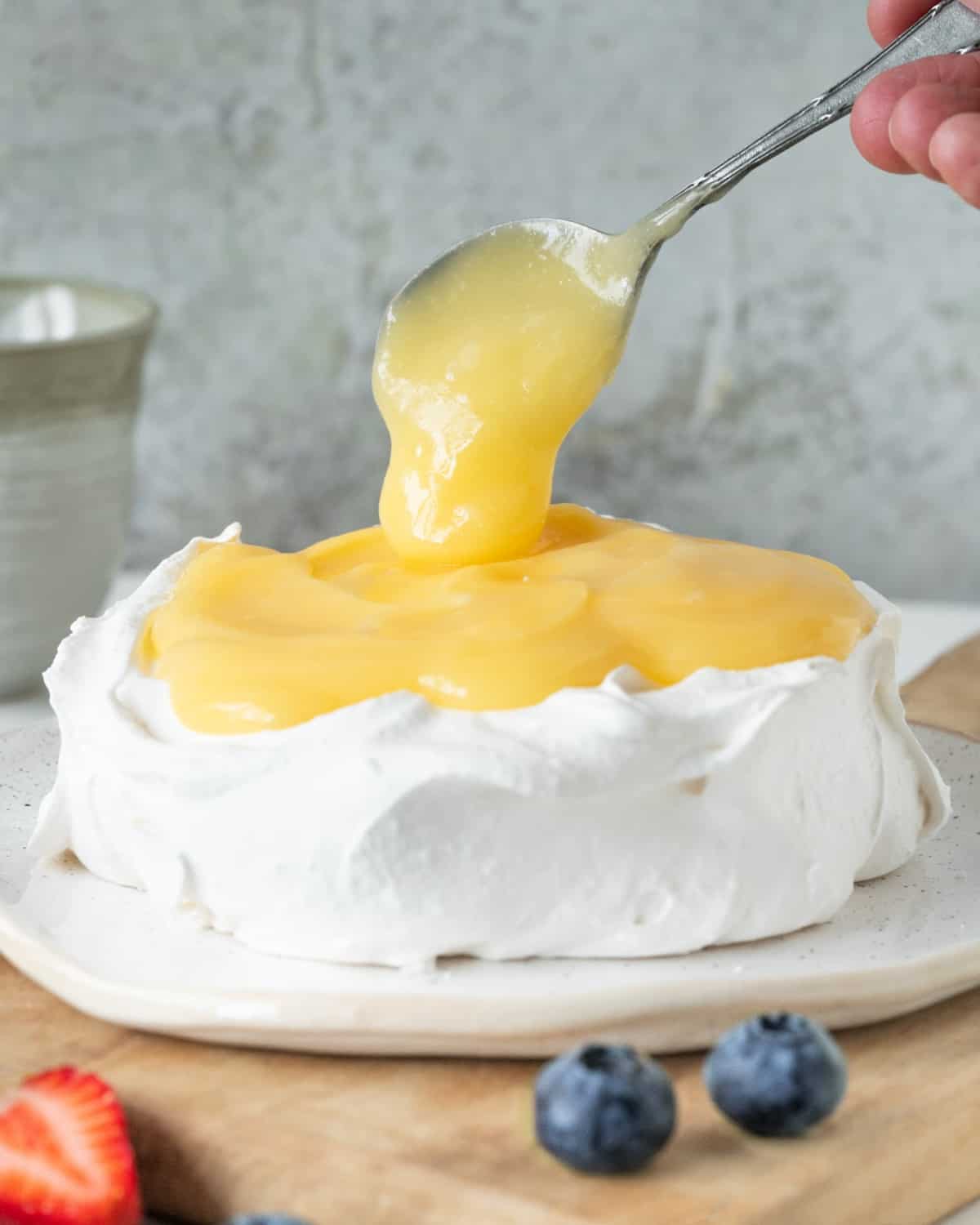
Lemon and berries: spread homemade lemon curd (or purchased) on the meringue shell and top it with a mix of fresh berries. Depending on how firm it is, it might drip a little if you add too much.
Strawberries and blueberries are usually available year-round. When in season blackberries and raspberries are a great addition.
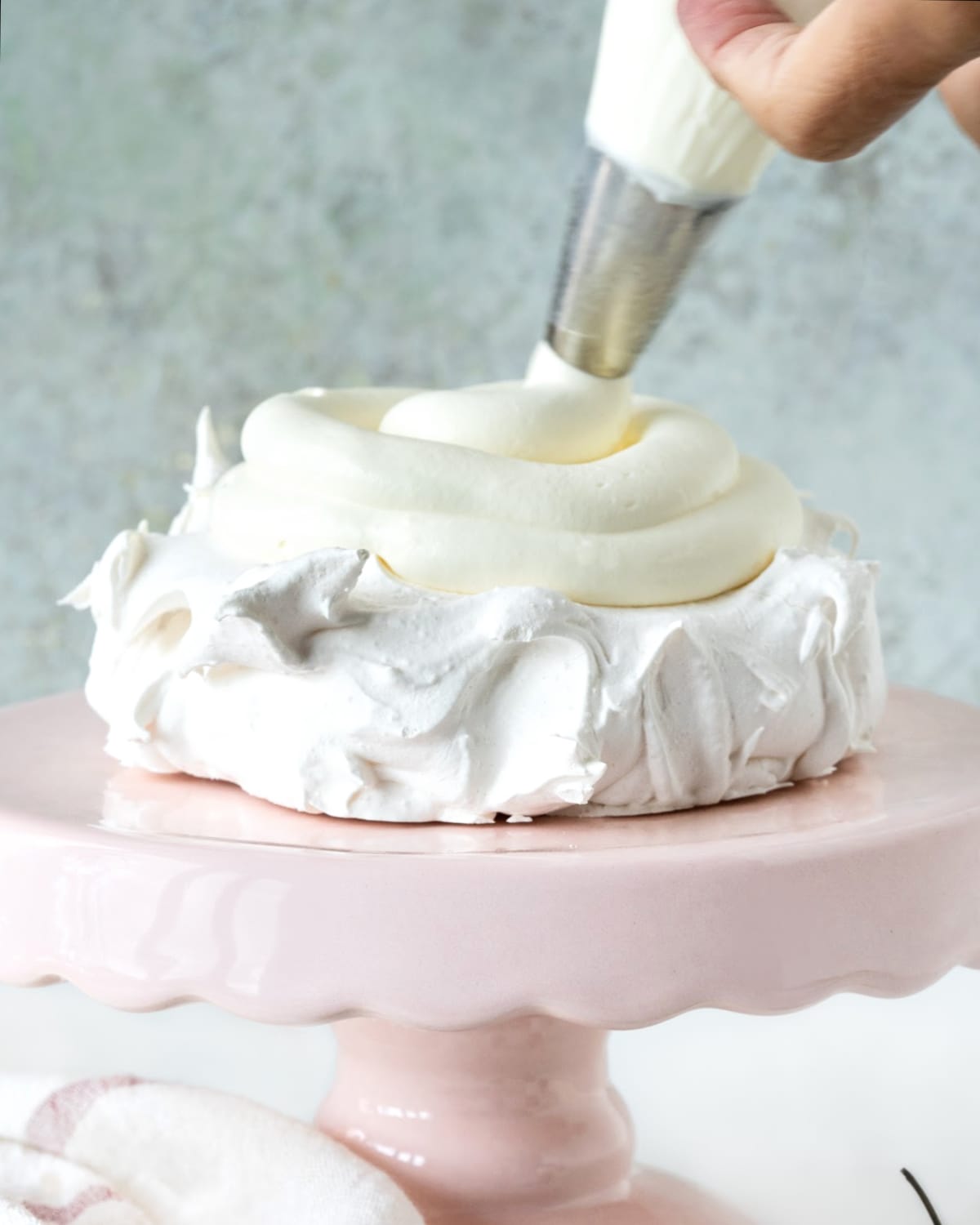
Cream and fruit: pipe sweet whipped cream and top with fresh cherries, strawberries or any other variety of fruit you like.
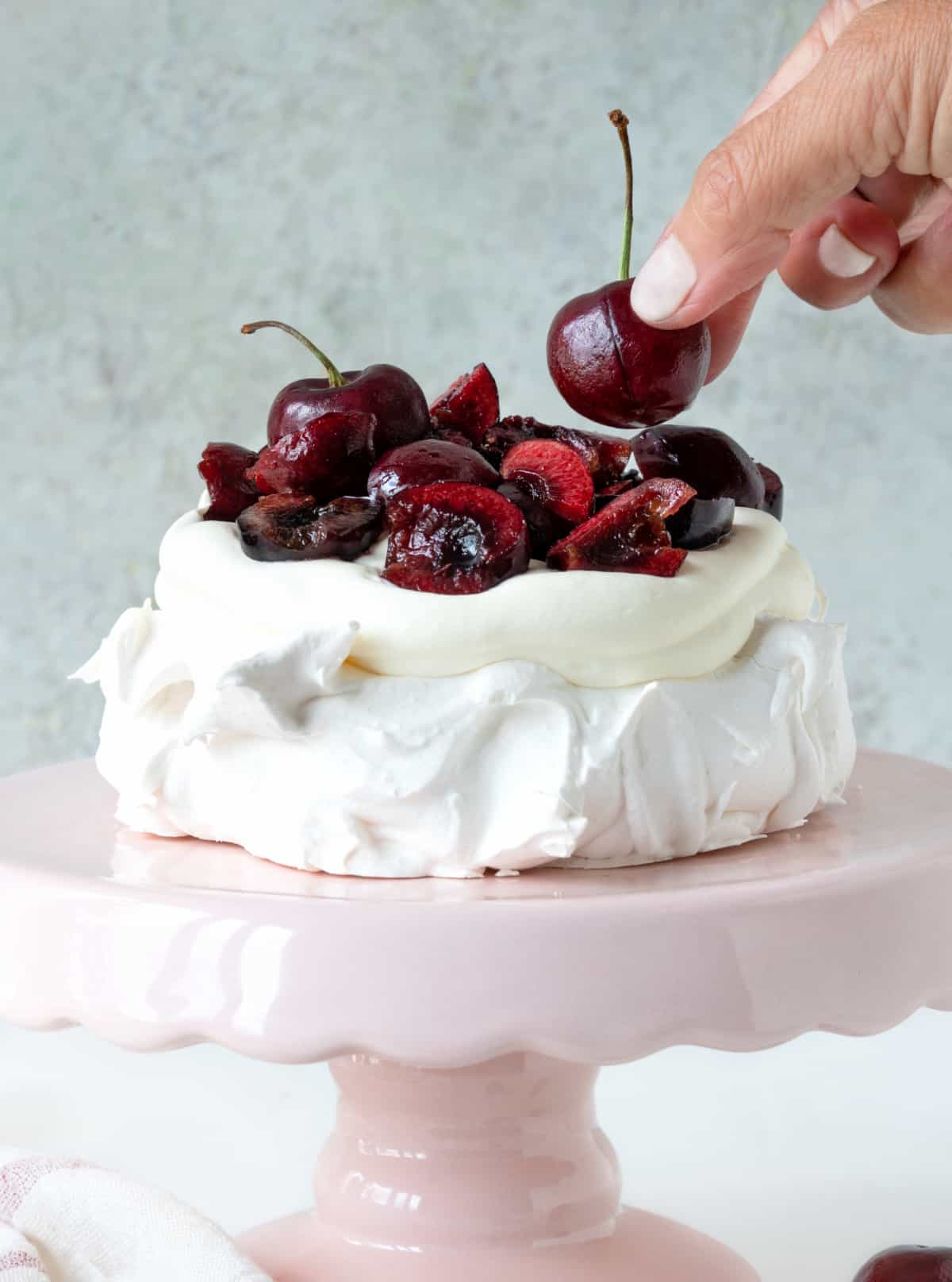
Storage
Meringues are a delicate confection that doesn't like humidity.
- Meringue discs: if the weather is dry and not humid, keep them in an airtight container at room temperature, in a cool, dry place. Do not refrigerate.
- Assembled pavlova: top right before serving, as it's the best way to preserve the crispness of the meringue and the freshness of the fruit.
- Leftovers: a pavlova should be enjoyed and served shortly after assembly. If refrigerated, it'll lose its crispness and might sweat. But if you have leftovers, keep them at room temperature for the first few hours and replace the fruit on top if it loses its shine. After a day, you might have to refrigerate it due to the whipped cream or other toppings.
- Hot or humid environment: you won't be able to keep leftovers at room temperature for long. Pavlova is a dessert for dry days.
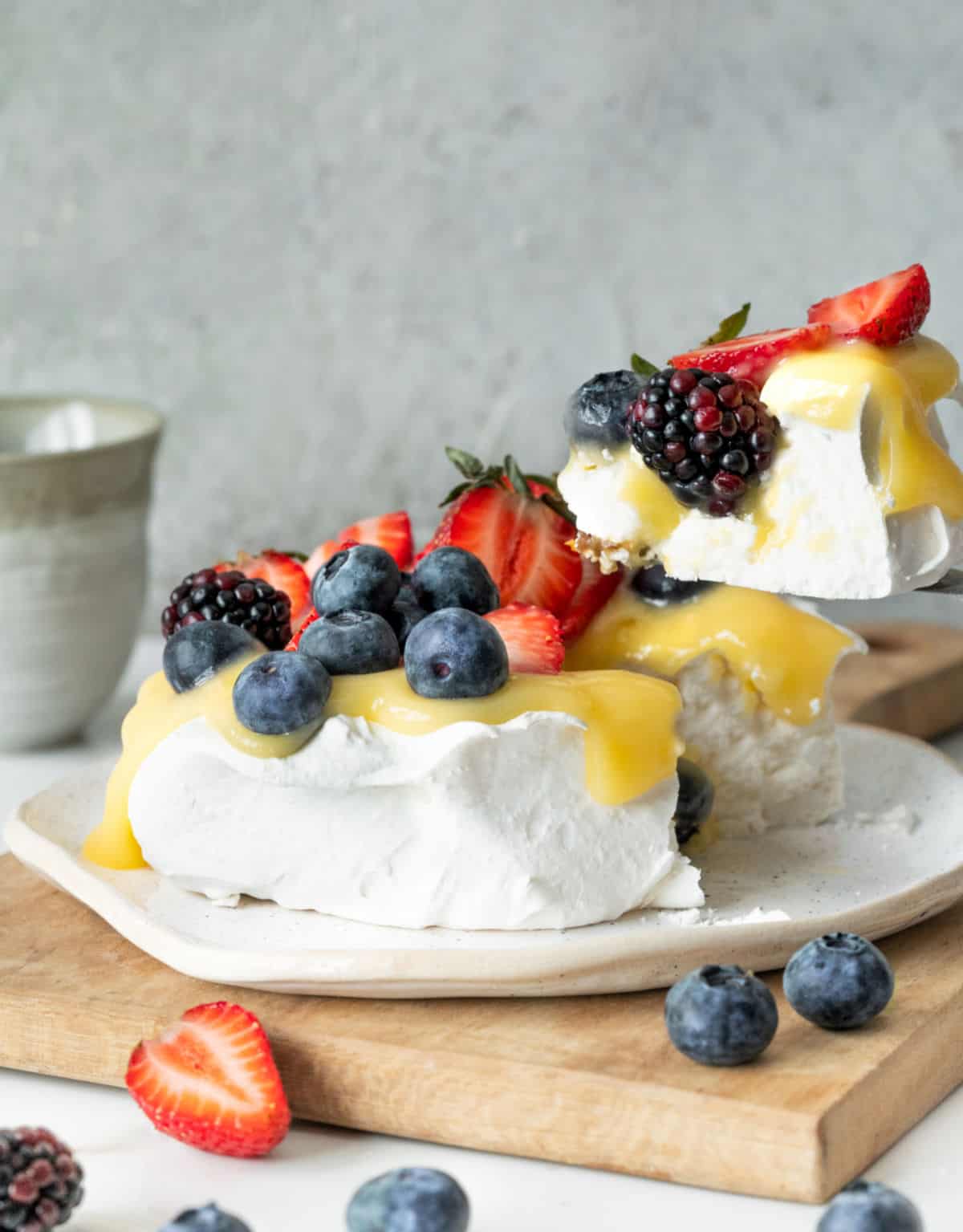
Related recipes you might like:
Before you go
If you made this recipe and loved it, you can comment below and leave a five-star ⭐️ review. Also, if you had issues, let me know so we can troubleshoot together.
You can also subscribe to our FREE email series 'Baking the Best' and our regular newsletter. Or follow and save my recipes on Pinterest.
As an Amazon Associate, I earn from qualifying purchases. Read my disclosure policy.
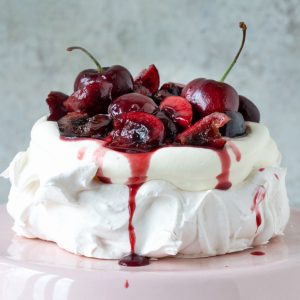
Pavlova Recipe (meringue dessert)
Ingredients
- 4 fresh egg whites, 160g at room temperature
- Pinch of salt
- 250 g 1 ¼ cups white superfine sugar
- 2 teaspoons cornstarch
- 1 teaspoon white vinegar
Whipped cream topping:
- 1 cup heavy cream
- 2 tablespoons powdered sugar
- 1 ½ cups fresh cherries, pitted (a few whole for decoration)
Lemon berry topping:
- 1 recipe homemade lemon curd, or use store-bought
- 1 ½ cups fresh mixed berries
Instructions
- Turn on the oven to 350°F (180°C) (medium, then we will lower it).
- Line a baking sheet with parchment paper.
For the meringue mixture:
- Beat the egg whites with the salt in the bowl of a stand mixer. You can use an electric mixer, but it’ll take longer to properly beat the whites.
- Start beating at low speed, then increase to medium speed, and when the egg whites start to form a peak, increase to high speed and add the sugar gradually. Don’t add it all at once.
- Beat until firm peaks form; that means when you lift the beater (turn off the mixer first), the peak tip stands straight up and doesn’t tilt.
- If you check once or twice during the beating, you’ll see that you'll go from soft peaks to stiffer peaks, with the tip holding a little firmer every time. That means the whipping is going well.
- Turn off the mixer, remove the whisk attachment and add the sifted cornstarch and vinegar. With a rubber spatula, gently mix to incorporate, deflating the meringue mixture as little as possible.
- Your meringue is ready to be baked.
Baking the pavlova:
- You can use a piping bag with a smooth, large tip or two spoons for a more rustic-looking pavlova.
- Make circles on the prepared baking sheet, several small ones (for individual mini pavlovas) or one large one. It can be round, square or rectangular.
- Spoon a mound of meringue in the center of the shape you want to make and spread it carefully. Add more if you want a taller pavlova. Reinforce the edges if you want higher sides and a lower center (to encase the filling). Do it slowly and carefully so you can course-correct it.
- Carefully transfer the sheet to the preheated oven and immediately lower the temperature to 230°F (110°C), very low.
- Bake until the edges are firm and dry, but the center is barely soft to the touch. And, if handled gently, it begins to peel off the paper on its own when you lift it.
- The baking time depends on the size of the pavlova, the oven and the humidity of the day, but it takes 1 hour at least for a medium pav. If it's your first time, it’ll probably take a few tries to get the desired shapes and baking times and create a perfect pavlova.
- Turn off the oven and let it cool completely. I make it at night and leave until the next day. They might slightly crack as they cool, and that is normal.
Assembling the pavlova:
- Transfer the meringue disk to the serving plate or platter right before serving.
- Add the topping right before serving.
- Top with whipped cream or lemon curd and then with fresh berries.
- We love cream with fresh cherries or strawberries and lemon curd with mixed berries or raspberries. See Notes below.

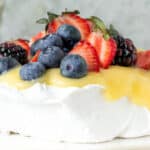

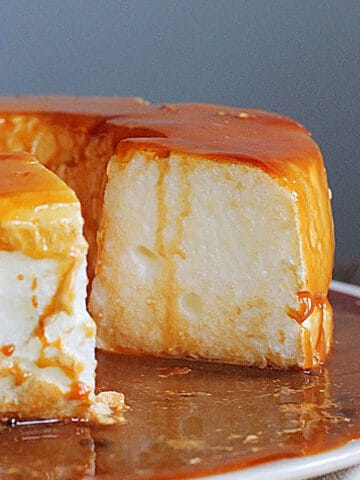
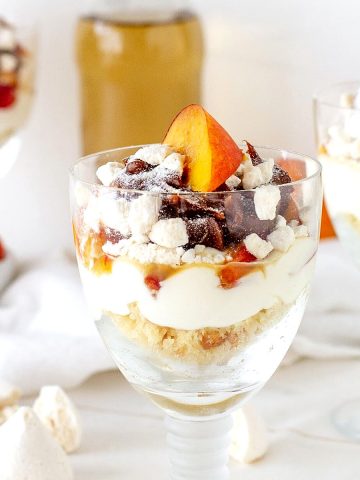
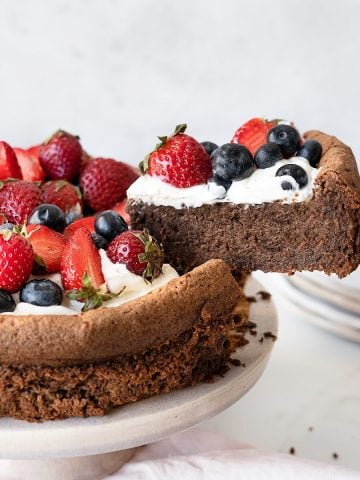
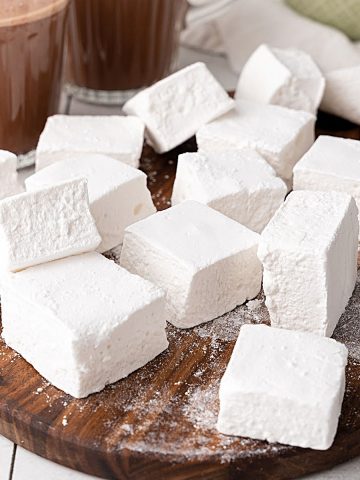
Rate and review this recipe